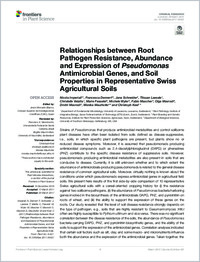Relationships between Root Pathogen Resistance, Abundance and Expression of Pseudomonas Antimicrobial Genes, and Soil Properties in Representative Swiss Agricultural Soils.
- Imperiali N Department of Fundamental Microbiology, University of LausanneLausanne, Switzerland.
- Dennert F Plant Pathology, Institute of Integrative Biology, Swiss Federal Institute of Technology (ETH) ZurichZurich, Switzerland.
- Schneider J Plant Pathology, Institute of Integrative Biology, Swiss Federal Institute of Technology (ETH) ZurichZurich, Switzerland.
- Laessle T Department of Fundamental Microbiology, University of LausanneLausanne, Switzerland.
- Velatta C Department of Fundamental Microbiology, University of LausanneLausanne, Switzerland.
- Fesselet M Plant Breeding and Genetic Resources, Institute for Plant Production Sciences, AgroscopeNyon, Switzerland.
- Wyler M Plant Pathology, Institute of Integrative Biology, Swiss Federal Institute of Technology (ETH) ZurichZurich, Switzerland.
- Mascher F Plant Breeding and Genetic Resources, Institute for Plant Production Sciences, AgroscopeNyon, Switzerland.
- Mavrodi O Department of Biological Sciences, University of Southern Mississippi, HattiesburgMS, USA.
- Mavrodi D Department of Biological Sciences, University of Southern Mississippi, HattiesburgMS, USA.
- Maurhofer M Plant Pathology, Institute of Integrative Biology, Swiss Federal Institute of Technology (ETH) ZurichZurich, Switzerland.
- Keel C Department of Fundamental Microbiology, University of LausanneLausanne, Switzerland.
- 2017-04-21
Published in:
- Frontiers in plant science. - 2017
Gaeumannomyces tritici
PGPR
Pseudomonas
Pythium ultimum
antimicrobial metabolites
disease suppressiveness
plant-beneficial activity
soil
English
Strains of Pseudomonas that produce antimicrobial metabolites and control soilborne plant diseases have often been isolated from soils defined as disease-suppressive, i.e., soils, in which specific plant pathogens are present, but plants show no or reduced disease symptoms. Moreover, it is assumed that pseudomonads producing antimicrobial compounds such as 2,4-diacetylphloroglucinol (DAPG) or phenazines (PHZ) contribute to the specific disease resistance of suppressive soils. However, pseudomonads producing antimicrobial metabolites are also present in soils that are conducive to disease. Currently, it is still unknown whether and to which extent the abundance of antimicrobials-producing pseudomonads is related to the general disease resistance of common agricultural soils. Moreover, virtually nothing is known about the conditions under which pseudomonads express antimicrobial genes in agricultural field soils. We present here results of the first side-by-side comparison of 10 representative Swiss agricultural soils with a cereal-oriented cropping history for (i) the resistance against two soilborne pathogens, (ii) the abundance of Pseudomonas bacteria harboring genes involved in the biosynthesis of the antimicrobials DAPG, PHZ, and pyrrolnitrin on roots of wheat, and (iii) the ability to support the expression of these genes on the roots. Our study revealed that the level of soil disease resistance strongly depends on the type of pathogen, e.g., soils that are highly resistant to Gaeumannomyces tritici often are highly susceptible to Pythium ultimum and vice versa. There was no significant correlation between the disease resistance of the soils, the abundance of Pseudomonas bacteria carrying DAPG, PHZ, and pyrrolnitrin biosynthetic genes, and the ability of the soils to support the expression of the antimicrobial genes. Correlation analyses indicated that certain soil factors such as silt, clay, and some macro- and micronutrients influence both the abundance and the expression of the antimicrobial genes. Taken together, the results of this study suggests that pseudomonads producing DAPG, PHZ, or pyrrolnitrin are present and abundant in Swiss agricultural soils and that the soils support the expression of the respective biosynthetic genes in these bacteria to various degrees. The precise role that these pseudomonads play in the general disease resistance of the investigated agricultural soils remains elusive.
- Language
-
- English
- Open access status
- gold
- Identifiers
-
- DOI 10.3389/fpls.2017.00427
- PMID 28424714
- Persistent URL
- https://folia.unifr.ch/global/documents/99619
Statistics
Document views: 10
File downloads:
- fulltext.pdf: 0
